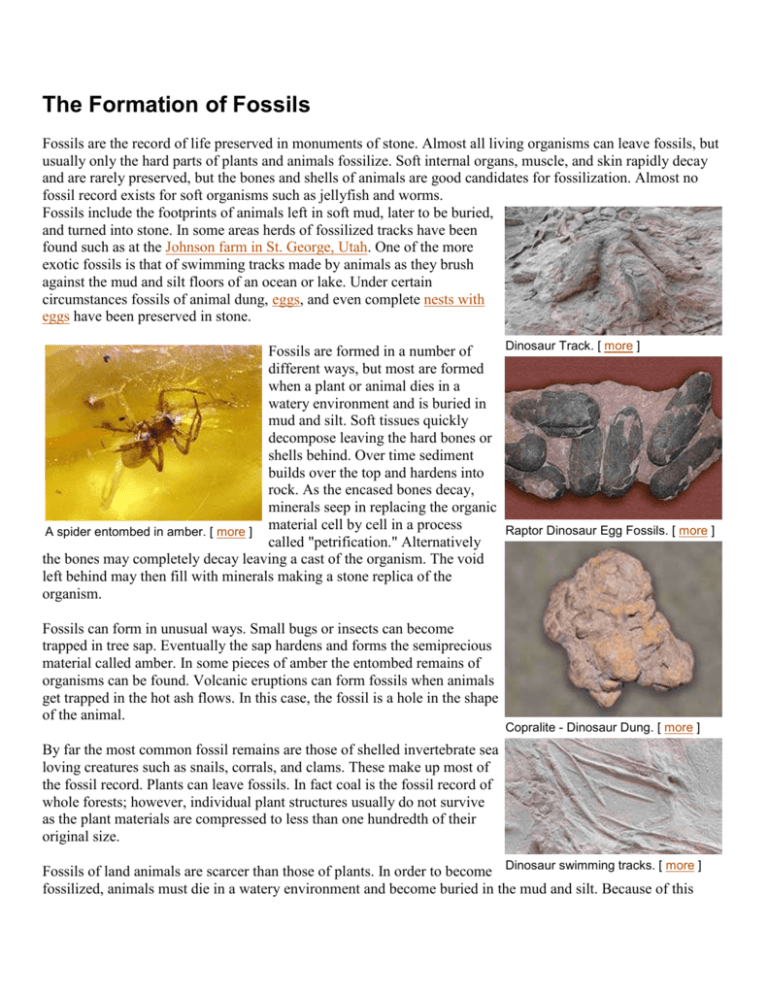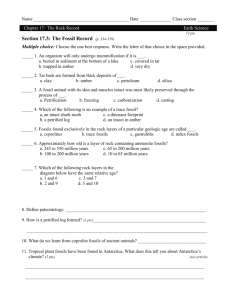
The Formation of Fossils
Fossils are the record of life preserved in monuments of stone. Almost all living organisms can leave fossils, but
usually only the hard parts of plants and animals fossilize. Soft internal organs, muscle, and skin rapidly decay
and are rarely preserved, but the bones and shells of animals are good candidates for fossilization. Almost no
fossil record exists for soft organisms such as jellyfish and worms.
Fossils include the footprints of animals left in soft mud, later to be buried,
and turned into stone. In some areas herds of fossilized tracks have been
found such as at the Johnson farm in St. George, Utah. One of the more
exotic fossils is that of swimming tracks made by animals as they brush
against the mud and silt floors of an ocean or lake. Under certain
circumstances fossils of animal dung, eggs, and even complete nests with
eggs have been preserved in stone.
Dinosaur Track. [ more ]
Fossils are formed in a number of
different ways, but most are formed
when a plant or animal dies in a
watery environment and is buried in
mud and silt. Soft tissues quickly
decompose leaving the hard bones or
shells behind. Over time sediment
builds over the top and hardens into
rock. As the encased bones decay,
minerals seep in replacing the organic
material cell by cell in a process
Raptor Dinosaur Egg Fossils. [ more ]
A spider entombed in amber. [ more ]
called "petrification." Alternatively
the bones may completely decay leaving a cast of the organism. The void
left behind may then fill with minerals making a stone replica of the
organism.
Fossils can form in unusual ways. Small bugs or insects can become
trapped in tree sap. Eventually the sap hardens and forms the semiprecious
material called amber. In some pieces of amber the entombed remains of
organisms can be found. Volcanic eruptions can form fossils when animals
get trapped in the hot ash flows. In this case, the fossil is a hole in the shape
of the animal.
Copralite - Dinosaur Dung. [ more ]
By far the most common fossil remains are those of shelled invertebrate sea
loving creatures such as snails, corrals, and clams. These make up most of
the fossil record. Plants can leave fossils. In fact coal is the fossil record of
whole forests; however, individual plant structures usually do not survive
as the plant materials are compressed to less than one hundredth of their
original size.
Fossils of land animals are scarcer than those of plants. In order to become Dinosaur swimming tracks. [ more ]
fossilized, animals must die in a watery environment and become buried in the mud and silt. Because of this
requirement most land creatures never get the chance to become fossilized unless they die next to a lake or
stream. Indeed there may be whole species of land animals in which no fossil record has been discovered. We
may never know how many and diverse these animals were.
contact us - copyright & disclaimer - search - privacy statement
Copyright © 2003 Calvin & Rosanna Hamilton. All rights reserved.






